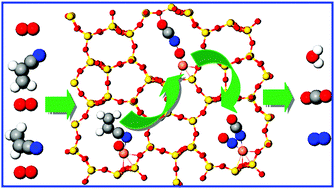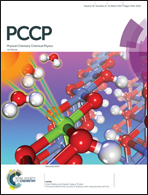Mechanistic insight into selective catalytic combustion of acrylonitrile (C2H3CN): NCO formation and its further transformation towards N2†
Abstract
A series of zeolite catalysts, M(Cu, Fe, Co)-ZSM-5, was prepared by an impregnation method and evaluated for the selective catalytic combustion of acrylonitrile (AN-SCC). Cu-ZSM-5, exhibiting the highest AN conversion activity and best N2 yield, was further selected for an AN-SCC mechanism investigation, wherein both experimental [in situ diffuse reflectance infrared Fourier transform spectroscopy (DRIFTS)] and theoretical [density functional theory (DFT)] approaches were employed. The in situ DRIFTS revealed that AN-SCC followed a hydrolysis mechanism at T < 300 °C via intermediates of acylamino species (–CONH2) and NH3, while it followed an oxidation mechanism at T > 300 °C via an intermediate of NCO. The DFT simulations gave much deeper insights suggesting that: (i) the NCO could be generated by oxidation of AN over [Cu]+ active sites, with an assistance of dissociated atomic O from gaseous O2; (ii) three types of reaction routes could be proposed for the further reaction of NCO to produce N2, namely NCO direct dissociation, NCO coupling, and NO + NCO reaction; and (iii) the last route (NO + NCO), possessing the lowest energy barrier, was the most probable reaction pathway, wherein the NO could be produced by oxidation of NCO. The DFT energy calculation results and microkinetic analyses revealed that the NCO generation step, possessing an energy barrier of 17.0 kcal mol−1 and a forward reaction rate constant of 2.20 × 107 s−1, was the rate-determining step of the whole catalytic cycle.



 Please wait while we load your content...
Please wait while we load your content...